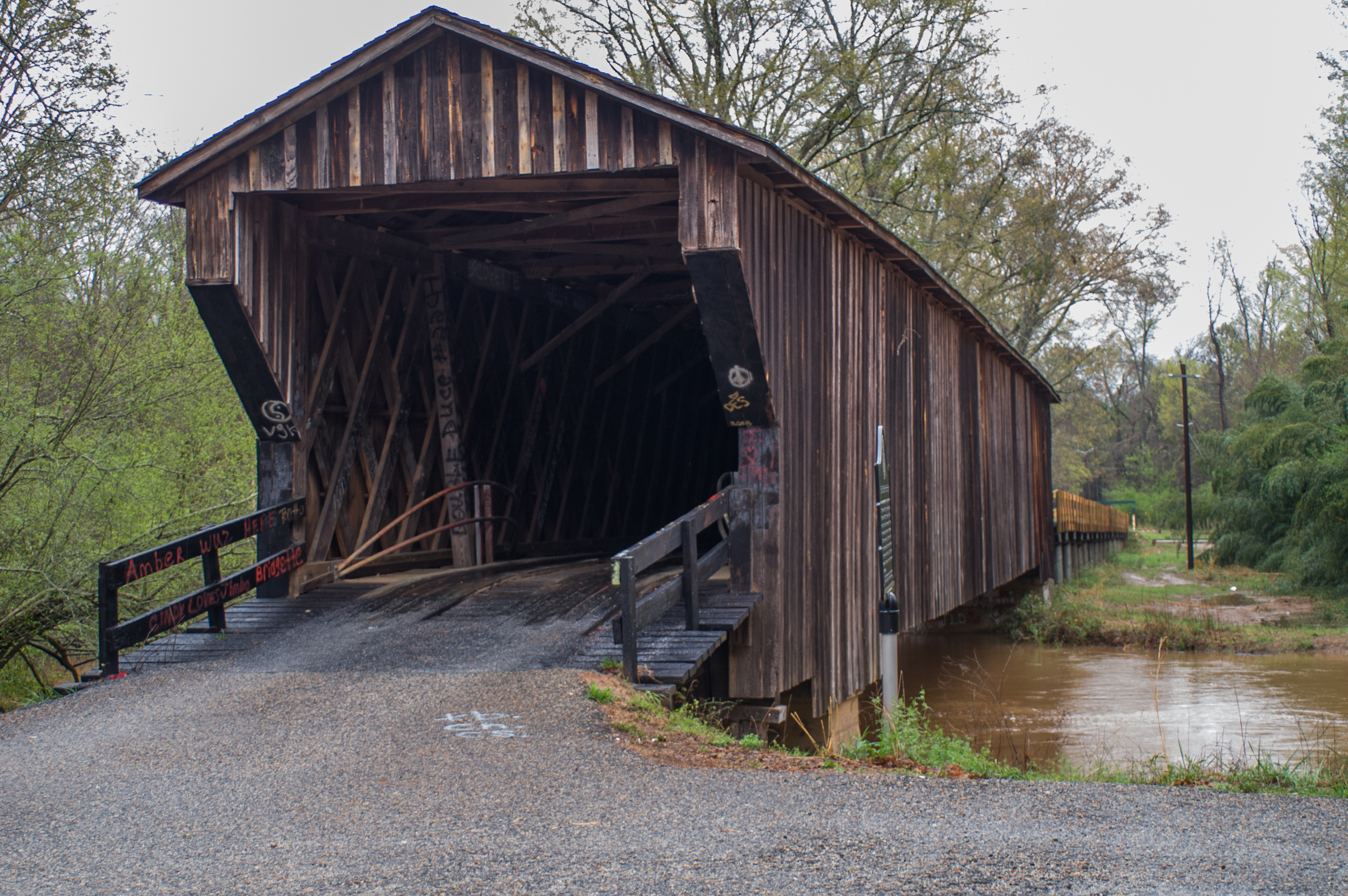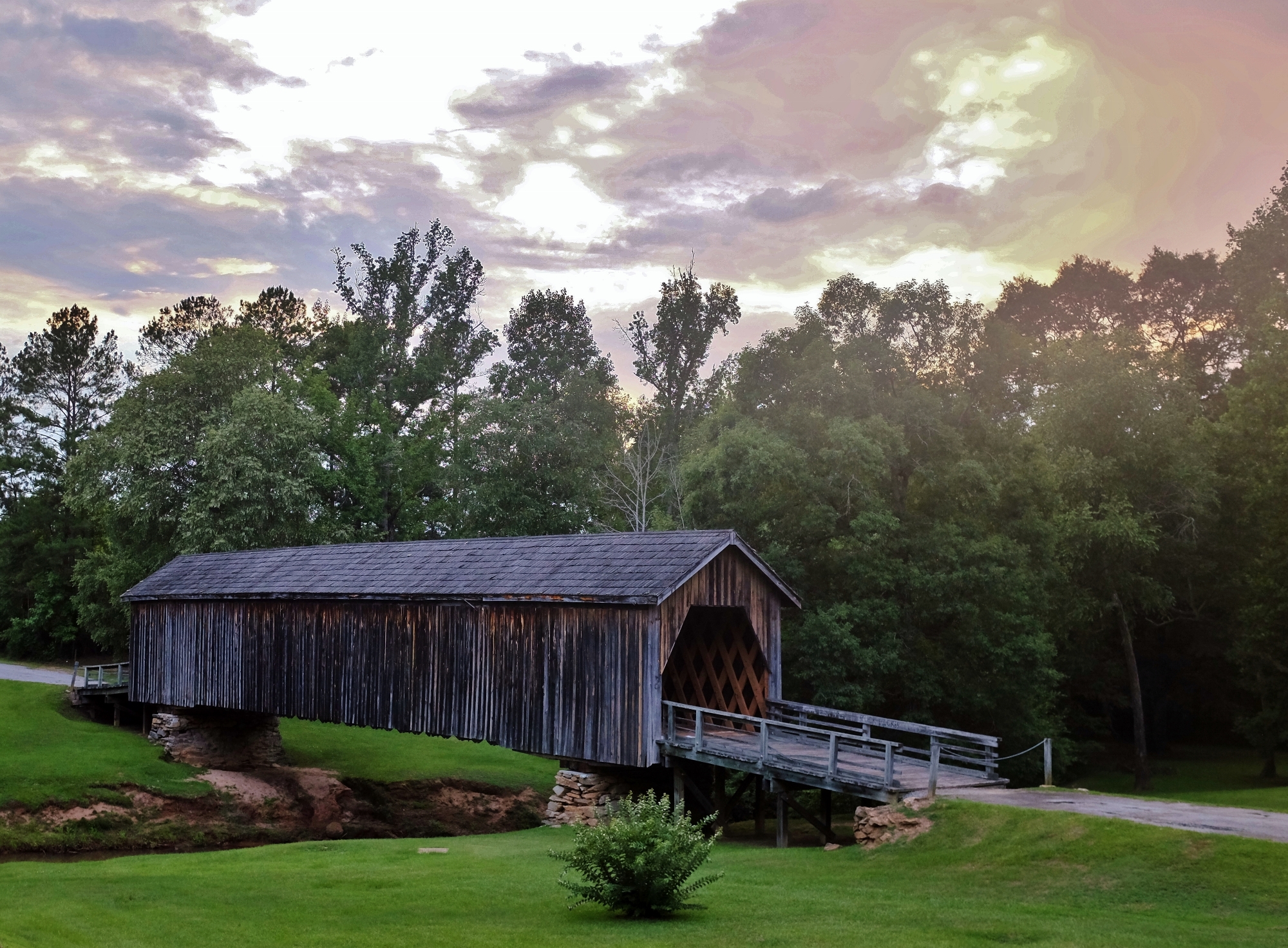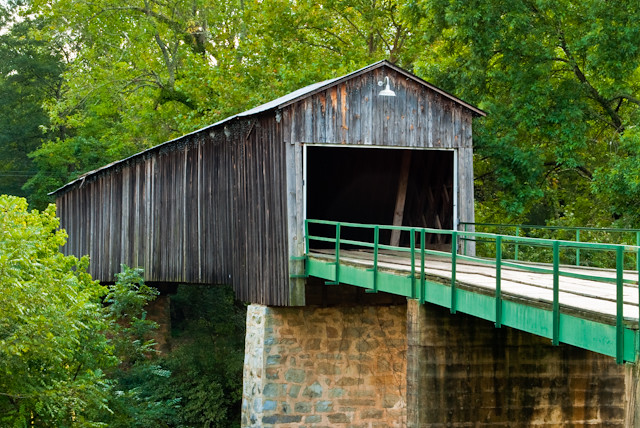Covered bridges make us think of a simpler time. They’re harder to find these days as roads are widened and natural disasters hit the wooden structures. The state of Georgia used to have over 200 covered bridges, but there are less than 20 today.
The History of Covered Bridges
The existence of the bridges can mostly be traced back to Horace King. He was born into slavery in South Carolina in 1807 but was freed from contractor John Godwin. King would go on to design the spiral staircase for the Alabama State Capitol as well as covered bridges in Georgia, Alabama, and Mississippi.
Known for his work using the Town Lattice Truss system, you can see this style in many of the state’s bridges. Plan a road trip for yourself to see the historic covered bridges in Georgia.
We’ve included the ones that are open to the public and mentioned if there is a fee to see it or if there is parking. And while there are a few modern covered bridges, we’ve only included the historic ones.
Covered Bridges in Georgia
Elder Mill Covered Bridge, Watkinsville

Built in 1897, Elder Mill Covered Bridge is located in Watkinsville, a few miles from Athens. While it was moved here from its original location in 1924, it’s one of a few that you can still drive through. It carries traffic without the support of steel beams. There’s a small parking area on the other side where you can stop for photos and walk down to Rose Creek below. It’s free to visit.
Watson Mill Covered Bridge, Comer

Located within Watson Mill Bridge State Park near Athens, this bridge is the longest original-site covered bridge in the state. It spans 229 feet across the South Fork River, first built in 1885. The town lattice truss bridge was built by Washington King, son of famous builder Horace King. The bridge sits atop scenic waterfalls. Visitors to the park can also experience hiking, camping, and other activities. Admission to the park is $5.
Stovall Mill Covered Bridge, Sautee Nacoochee

Fred Dover constructed the Stovall Mill Covered Bridge for his grist, saw, and shingle mill complex, but the original bridge washed away in the 1890s. This version was constructed in 1895 and is 33 feet long. Dover sold his operations to Fred Stovall, Sr., whose name the bridge now bears.
It’s one of the state’s shortest clear-span covered bridges and is built in the King-post design, named for famed bridge designer Horace King. It was featured in Susan Hayworth’s movie, “I’d Climb the Highest Mountain” and has a picnic area where you can park.
The road was moved in order to protect the bridge. Sadly, graffiti now covers the inside, but you can walk through before visiting the SNCA across the street. It’s free to visit and a short drive from Helen.
Red Oak Covered Bridge, Imlac

Another bridge built by Horace King, the Red Oak Creek Covered Bridge is the only one of his designs in the town lattice style to survive. Built in the 1840s, it spans 391 feet and is the oldest and longest covered bridge in the state. It has run across Red Oak Creek near Woodbury in Meriwether County for over 170 years. Sometimes called the Imlac Covered Bridge, it’s still in use. It is free to visit.
Auchumpkee Creek Covered Bridge, Thomaston

The Auchumpkee Creek Covered Bridge, located near Thomaston in an area formerly known as Hootenville, was built in 1892 for the price of about $1,200. Spanning 120 feet, the Town Truss designed bridge was designed by Dr. J. W. Herring.
The one here is actually the fourth on the site as others were destroyed or washed away. The bridge was closed to traffic in 1985. A tropical storm damaged the bridge in 1994, but federal disaster relief money and local fundraising rebuilt the bridge, albeit at a shorter length. It has a picnic area and parking.
Coheelee Creek Covered Bridge, Blakely

Blakely’s Coheelee Creek Covered Bridge was first built in 1891 at Macdonald’s Ford. It is the southernmost covered bridge in the United States. It has double spans and is 96 feet long. A concrete support system was added in the 1950s. The bridge is free to visit. It’s no longer open to cars but is open to pedestrians.
Concord Covered Bridge, Smyrna

Located in the north Atlanta suburb of Smyrna, Concord Covered Bridge was built in 1872 over Nickajack Creek. It spans 131 feet long and is still open to one lane of traffic. Built for Ruff’s Mill, the area was the site of a Civil War battle and many of the surrounding structures have been turned into private homes.
Originally built with two spans, the bridge has been widened over the years and steel beams were added in the 1950s. The Silver Comet Trail runs nearby and this is the only place to park. Don’t park in front of the homes at risk of being towed. It’s free to visit.
Cromer’s Mill Covered Bridge, Carnesville
Named for the Cromer family that settled nearby in 1845 and later opened a woolen mill, Cromer’s Mill Covered Bridge was built in 1907 near Royston. It spans 110 feet in the Town lattice design. A descendant of the original family built the stone abutments used today. You can no longer drive through it, but the bridge is free to visit and walk across.
Euharlee Covered Bridge, Euharlee

Like the Watson Mill Bridge, Euharlee Creek Covered Bridge was built in 1886 by Washington King. The 138-foot bridge was constructed for the nearby mill in the Town lattice style. Set over the Euharlee Creek near Cartersville, the bridge is now a part of a history museum open a few days per week. It closed to traffic in 1980. The welcome center has free parking for visitors to the bridge.
Poole’s Mill Covered Bridge, Cumming

Built in 1820 for the grist mill owned by Cherokee Chief George Welch, Poole’s Mill Bridge Park was later named for a local doctor. While the original bridge washed away in 1899, a new Lattice truss bridge was soon after constructed.
After damage in the 1990s, the community banded together to restore it. A support pier was added and the area around it was developed into a public park. It’s no longer open to traffic but free to visit.
George L. Smith State Park Covered Bridge, Twin City

Located within George L Smith State Park, the area named for a former House of Representatives member includes the 1880 Watson Mill dam, grist mill, and the covered bridge. Cypress trees line the pond, making it a favorite of outdoors lovers. There’s also a museum dedicated to the history of the site. The park has hiking trails and campsites and admission to the park is $5.
Stone Mountain Bridge, Stone Mountain

Stone Mountain has its own covered bridge, originally built in 1891 in Athens to cross the Oconee River. The pine and cedar bridge was moved to the park in the 1960s and is 150 feet long. It leads visitors to the Indian Island section of the park.
Washington King also built this bridge in the Town lattice style. At the site, you’ll find a historic marker, picnic area, and parking for visitors. It’s still open to traffic. Admission to the park starts at $27 and it includes access to other park attractions.
PIN IT




You might consider adding the covered bridge at Hurricane Shoals on the North Oconee River in Maysville, Ga. It still allows one way auto traffic, with a span of 127 feet. It was burned in 1972, but was rebuilt for the park in 2002. I love your website – thanks for documenting the history we are losing.
http://www.hurricaneshoalspark.org
https://en.m.wikipedia.org/wiki/List_of_covered_bridges_in_Georgia_(U.S._state)
Why are there covered bridges in Georgia? Does it show that much in the mountains that it’s worth the extra construction to keep the bridges clear?